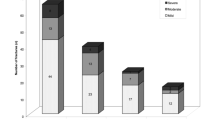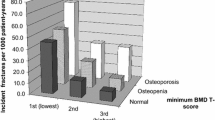Abstract
Summary
Prevalent fracture and BMD are core elements of fracture prediction. In this control study case, we demonstrate that a simple computer-based estimation of local irregularities in the alignment of the lumbar vertebrae independently contributes to the fracture risk, thus supplementing current diagnostic tools.
Introduction
We tested the hypothesis that degree of lordosis and/or irregularity in the alignment of lumbar vertebrae could be contributors to the risk of fragility fractures.
Methods
This was a case-control analysis including 144 elderly women; 108 maintaining skeletal integrity, whereas 36 sustaining a lumbar vertebral fracture during a 7.5-year observation period. The two groups of women were carefully matched for age, BMI, spine BMD and numerous classic risk factors. Lateral X-rays of the lumbar spine were digitized and the four corner points of endplates on each vertebra from Th12 to L5 were annotated. The degree of lordosis and irregularity of vertebral alignment was assessed by image analysis software.
Results
Degree of lordosis was not predictive for fractures. In contrast, irregularity was significantly higher in those who later sustained a fracture (1.6 × 10−2vs. 2.0 × 10−3 cm−1, p < 0.001), and further increased upon a sustained fracture (2.8 × 10−2 cm−1, p < 0.001), but was unchanged in controls (1.6 × 10−2 cm−1). The predictive value of irregularity was independent of classic risk factors of fractures, including BMD (p < 0.01).
Conclusion
Our results suggest that the herein introduced simple measure of irregularities in vertebral alignment could provide useful supplement to the currently used diagnostic tools of fracture prediction in elderly women.




Similar content being viewed by others
References
Watts NB (2001) Osteoporotic vertebral fractures. Neurosurg Focus 10:E12
Truumees E (2003) Medical consequences of osteoporotic vertebral compression fractures. Instr Course Lect 52:551–558
McClung MR (2005) The relationship between bone mineral density and fracture risk. Curr Osteoporos Rep 3:57–63
Hayes WC, Piazza SJ, Zysset PK (1991) Biomechanics of fracture risk prediction of the hip and spine by quantitative computed tomography. Radiol Clin North Am 29:1–18
Bouxsein ML, Melton LJ 3rd, Riggs BL et al (2006) Age- and sex-specific differences in the factor of risk for vertebral fracture: a population-based study using QCT. J Bone Miner Res 21:1475–1482
Ross PD, Huang C, Davis JW, Wasnich RD (1995) Vertebral dimension measurements improve prediction of vertebral fracture incidence. Bone 16:257S–262S
Briggs AM, Wrigley TV, van Dieen JH et al (2006) The effect of osteoporotic vertebral fracture on predicted spinal loads in vivo. Eur Spine J Jul 4
Kado DM, Greendale GA, Lui L, Ensrud KE, Fink HA, Hillier T, Cummings SR (2003) Hyperkyphosis predict mortality independent of vertebral osteoporosis in older women. J Bone Miner Res 18:S249
Bagger YZ, Tanko LB, Alexandersen P, Hansen HB, Qin G, Christiansen C (2006) The long-term predictive value of bone mineral density measurements for fracture risk is independent of the site of measurement and the age at diagnosis: results from the Prospective Epidemiological Risk Factors study. Osteoporos Int 17:471–477
Zebaze RMD, Maalouf G, Maalouf N, Seeman E (2004) Loss of regularity in the curvature of the thoracolumbar spine: a measure of structural failure. J Bone Miner Res 19:1099–1104
Farfan HF (1978) The biomechanical advantage of lordosis and hip extension for upright activity: man as compared with other anthropoids. Spine 3:336–342
Huang MH, Barrett-Connor E, Greendale GA, Kado DM (2006) Hyperkyphotic posture and risk of future osteoporotic fractures: the Rancho Bernado study. J Bone Miner Res 3:419–423
Hasserius R, Redlund-Johnell I, Mellstrom D, Johansson C, Nilsson BE, Johnell O (2001) Vertebral deformation in urban Swedish men and women: prevalence based on 797 subjects. Acta Orthop Scand 72:273–278
Johansson C, Mellstrom D, Rosengren K, Rundgren A (1994) A community-based population study of vertebral fractures in 85-year-old men and women. Age Ageing 23:388–392
Genant HK, Wu CY, van Kuijk C, Nevitt MC (1993) Vertebral fracture assessment using a semiquantitative technique. J Bone Miner Res 8:1137–1148
Rose MD (1975) Functional proportions of primate lumbar vertebral bodies. J Hum Evol 4:1–38
Kaptoge S, Armbrecht G, Felsenberg D, Lunt M, O’Neil TW, Silman AJ, Reeve J (2004) When should the doctor order a spine X-ray? Identifying vertebral fractures for osteoporosis care: results from the European prospective osteoporosis study (EPOS). J Bone Miner Res 19:1982–1993
Kayanja MM, Ferrara LA, Lieberman IH (2004) Distribution of anterior cortical shear strain after a thoracic wedge compression fracture. Spine J 4:76–87
Gaintanis IN, Carandang G, Phillips FM et al (2006) Restoring geometric and loading alignment of the thoracic spine with a vertebral compression fracture: effects of balloon (bone tamp) inflation and spinal extension. Spine J 5:45–54
Author information
Authors and Affiliations
Corresponding author
Rights and permissions
About this article
Cite this article
Pettersen, P.C., de Bruijne, M., Chen, J. et al. A computer-based measure of irregularity in vertebral alignment is a BMD-independent predictor of fracture risk in postmenopausal women. Osteoporos Int 18, 1525–1530 (2007). https://doi.org/10.1007/s00198-007-0388-y
Received:
Accepted:
Published:
Issue Date:
DOI: https://doi.org/10.1007/s00198-007-0388-y




